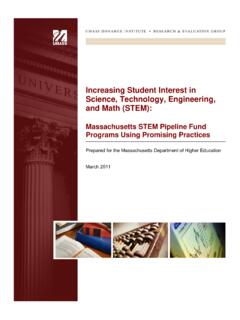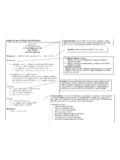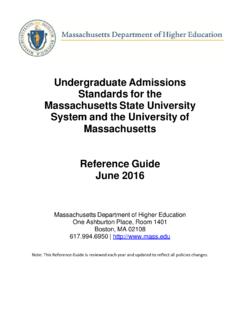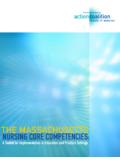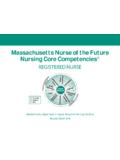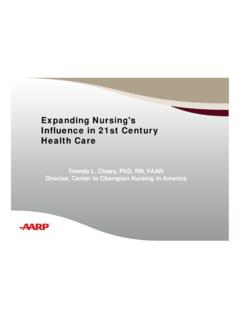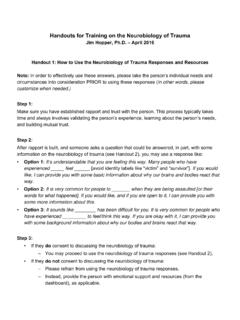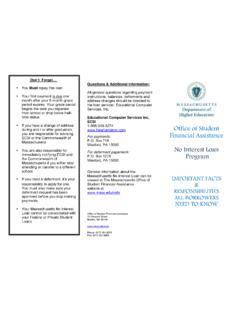Transcription of Advanced Manufacturing Workforce Plan
1 Advanced Manufacturing Workforce plan A Foundation for Our Future Spring 2015. Massachusetts Department of Higher Education Page 1. Tables .. 3. Charts .. 3. Executive 4. Gap Analysis .. 6. Program Alignment and System Capacity .. 6. Student 6. Next Generation Workforce .. 7. Introduction .. 8. Workforce 8. Advanced Manufacturing .. 9. Production Workforce .. 10. Industry Segmentation and Workforce Characteristics .. 11. Production and Technical Workforce Projections .. 12. Talent Demand - Statewide .. 12. Talent Supply .. 14. Talent 16. Rising Education Expectations .. 17. Next Generation Advanced 18.
2 Innovation, Transformation, and the Future Workforce .. 18. University Research 19. National 20. Statewide and Regional Workforce Coordination .. 21. Massachusetts Advanced Manufacturing Collaborative .. 21. Regional and Statewide Partnerships .. 22. Funding Sources .. 22. Conclusion .. 23. Appendix A Sub-Sector Characteristics .. 24. Figure 1 Regions .. 27. Appendix B Occupational Demand Estimation Method .. 28. Massachusetts Department of Higher Education Page 2. Appendix C Talent Demand Regional and Sub-sector Detail .. 31. Table 4 Annual Job Openings by Region in Manufacturing Production and Technical Occupations.
3 31. Table 5 Job Postings in Advanced Manufacturing Production and Technical Occupations by Region 120 Days ending May 11, 2015 .. 32. Table 6 Job Postings in Advanced Manufacturing Production and Technical Occupations by 32. Appendix D Manufacturing Programs at Massachusetts High 33. Appendix E Manufacturing Certificates and Associates Degrees by Institutions .. 38. Appendix F Manufacturing Related Non-Credit Course Enrollment by Community College and Course Title .. 42. Appendix G Top Technical Skills from Current Online Job Postings .. 49. Appendix H University Research Centers .. 52. Appendix I Approved Manufacturing Institutes.
4 56. Tables Table 1 Production and Technical Workforce Demand from Table 2 Graduates of Manufacturing Programs at Comprehensive and Career Vocational Technical High Schools (CVTE) and Community Colleges ..15. Table 3 Not-for-Credit Manufacturing Training at Massachusetts Community Colleges .. 16. Table 4 Annual Job Openings by Region in Manufacturing Production and Technical 31. Table 5 Job Postings in Advanced Manufacturing Production and Technical Occupations by Region 120. Days ending May 11, 2015 ..32. Table 6 Job Postings in Advanced Manufacturing Production and Technical Occupations by Sub-Sector.
5 32. Charts Chart 1 Percent of Massachusetts Workers Earning at least 45K Annually by 11. Massachusetts Department of Higher Education Page 3. Advanced Manufacturing Workforce plan A Foundation for our Future Executive Summary plan Context Workforce planning is an initiative of the Department of Higher Education's (DHE) Vision Project to inform the Board of Higher Education (BHE) about current and future trends that impact the skills gap in key economic sectors of Massachusetts' economy. Beginning in 2010, the DHE initiated Workforce planning for the healthcare sector. A coalition of employers, educators, state government agency representatives and industry leaders were convened to address the then-looming competency gaps and pipeline constraints of the nursing Workforce .
6 This work continues today. The nursing Workforce plan was followed by the Allied Health - Direct Care plan (2014) and IT/Tech plan (2014), each built upon the foundation provided by Massachusetts' plan for STEM Education , Expanding the Pipeline for All (2014). In 2011, the Executive Office of Housing and Economic Development established the Advanced Manufacturing Collaborative (AMC) to address an array of challenges faced by this sector, including Workforce development. Given the importance of the Manufacturing sector to the Commonwealth's economy and public higher education's role in preparing this Workforce , the DHE has prioritized the development of this plan to inform the BHE and complement the ongoing work of the AMC.
7 It is important to note that a substantial body of national and state-level research is available that describes the challenges of the Manufacturing sector, including a strong emphasis on Workforce development. To inform the development of this plan the DHE conducted a careful although most certainly incomplete review of the available literature, as well as personal interviews with members of Massachusetts' Advanced Manufacturing community. Current Pathways and View to the Future The DHE has identified two primary topics for attention through this plan . The first is to assess the current Manufacturing education pathways that span vocational education schools and community colleges and size the output of this pipeline to assess the supply/demand talent gap.
8 These pathways serve (1) traditional-age and adult students in day and evening programs at vocational schools, (2) community college students pursuing certificate and degree Massachusetts Department of Higher Education Page 4. programs, and (3) adult students enrolled in not-for-credit training programs (grant and employer funded) at the community colleges. Private sector and not-for-profit partners also make important contributions to these education pathways. The second topic is to look beyond the requirements of today's Advanced Manufacturing Workforce to new and possibly higher-level competencies that will be required of the next generation Workforce .
9 While the current focus of Workforce demand is centered on today's definition of the production Manufacturing worker, accelerating advances in materials, technologies and supply chain processes will require a Workforce with substantially new and different knowledge, skills and abilities to build the products of the future. The public higher education system must consider and address these trends well in advance of employer demand as there is a lead-time to develop academic programs and in the 21st century economy; market opportunities will not wait. A well prepared, readily available and agile next generation Workforce will be an important competitive advantage for the Commonwealth.
10 Scale of Implementation Within these two topics one theme stands out. That is the need for a greater SCALE of implementation of Workforce development. The ability to identify and take effective programs to scale, statewide, may be the single most important and as yet unmet challenge in Workforce development. Vocational high schools, community colleges and state universities have successfully demonstrated the ability to align curriculum with industry requirements and develop stackable credential pathway programs to address local Workforce challenges. However, these programmatic responses are too often boutique in nature, not designed to comprehensively and sustainably upgrade the skills of the incumbent Workforce , build a pipeline of new workers to support sector transformation and growth, and provide backfill for retiring workers and other routine turnover.
